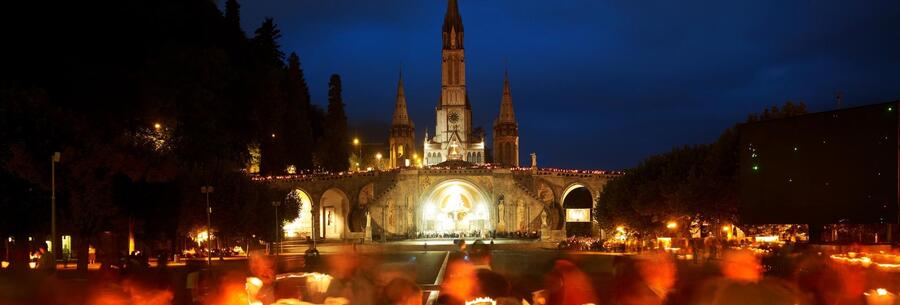The Rosary Pilgrimage to Lourdes is a major spiritual event that brings together thousands of pilgrims every year from all over France and beyond to experience an intense moment of prayer, fraternity and contemplation in the heart of the Pyrenees. Organised by the Dominican family, this pilgrimage generally takes place at the beginning of October, coinciding with the feast of Our Lady of the Rosary, celebrated on 7 October. It's a special opportunity for the faithful to come and pray to the Virgin Mary in this emblematic place of Catholicism, where the young Bernadette Soubirous reported having seen the Virgin eighteen times in 1858.
The history of the Rosary pilgrimage
The Rosary pilgrimage came into being at the end of the 19th century under the impetus of the Dominicans. Inspired by Marian spirituality and deeply attached to praying the Rosary, this event quickly became a must for French Catholics. Through their mission of evangelisation and preaching, the Dominicans have always attached great importance to praying the Rosary, a meditative prayer centred on the life of Christ and his mother, the Virgin Mary.
The choice of Lourdes as a pilgrimage destination is closely linked to the importance that this place holds in the hearts of believers. Lourdes has become one of the largest Catholic pilgrimage centres in the world since the Marian apparitions of 1858. Every year, millions of pilgrims flock there, seeking spiritual comfort, healing and hope. It is against this backdrop that the Rosary pilgrimage takes place, offering the faithful the opportunity to renew their faith, pray for their loved ones and deepen their relationship with God through meditation on the mysteries of the Rosary.
The structure of the pilgrimage
The Rosary pilgrimage generally spans several days, with a rich and varied programme. It includes Eucharistic celebrations, torchlight processions, rosaries, confessions, catechesis and, of course, praying the Rosary, which is at the heart of the event. Each day is marked by a particular spiritual theme, often linked to the teachings of the Church and the mysteries of the Rosary.
One of the highlights of the pilgrimage is the torchlight procession, which takes place in the evening as night falls. Thousands of pilgrims, candles in hand, advance in procession through the streets of Lourdes, singing hymns to the glory of Mary. It is a moment of great emotion, when the communion of believers and the spiritual fervour that animates each of them is intensely felt.
As well as the liturgical celebrations, the Rosary pilgrimage pays particular attention to welcoming the sick and people with disabilities. Lourdes is known as a place of healing, and many pilgrims come here in the hope of finding physical or spiritual healing. The hospitaliers, dedicated volunteers, accompany the sick throughout the pilgrimage, offering support and comfort.
An experience of faith and community
The Rosary pilgrimage to Lourdes is much more than just a religious journey. It is a true experience of faith and community. Pilgrims from all walks of life come together to share moments of prayer, exchange and solidarity. It's a unique opportunity to get away from their daily lives, refocus on what's essential and rediscover the depth of the Rosary prayer.
For many, this pilgrimage is also a chance to take a break from their often hectic lives, step back and reflect on their relationship with God. The catechesis and meditation sessions offered throughout the pilgrimage enable pilgrims to deepen their faith, rediscover the Rosary prayer and open themselves up to the action of divine grace.
The community aspect of the pilgrimage is also very important. Pilgrims, whether in groups or individually, come together to experience moments of sharing, joy and mutual support. The fraternity that develops over the course of these few days is often a source of great friendship and spiritual unity.
The message of Lourdes
Lourdes, by virtue of its history and its importance in Catholic tradition, is a place that carries a profound message: that of the merciful love of God and the powerful intercession of Mary. The Rosary pilgrimage enables this message to be relived through the various activities on offer, and in particular through the Rosary prayer, which invites the faithful to contemplate the mysteries of Christ's life with Mary.
The shrine of Lourdes also reminds us of the importance of charity and service to those most in need, especially the sick and suffering. At every Rosary pilgrimage, this dimension of charity is emphasised, and the hospitaliers, as well as the many volunteers, embody this spirit of service and love of neighbour.
Conclusion
The Rosary pilgrimage to Lourdes is a landmark spiritual event, offering believers the opportunity to draw closer to God through prayer, meditation and meeting other pilgrims. It's a highlight of the year for those seeking to renew their faith, find inner peace or pray for intentions close to their hearts. Lourdes, with its atmosphere of peace, recollection and healing, remains an essential place for all those who wish to have a profound spiritual experience. The Rosary pilgrimage, with its rich programme of prayers and celebrations, allows everyone to recharge their batteries and draw closer to the mystery of divine love, always in communion with Mary, Mother of Christ and model of faith.




















